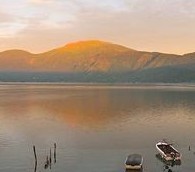Destination: El Salvador
Lightning Flashes in El Salvador
by Tracy L. Barnett | 10.27.10 | 10:02 AM ET
Tracy L. Barnett stepped off a bus, checked into a luxury resort and learned something about the indifferent forces of nature
World Travel Watch: Turmoil in Kashmir, Criminal Gangs in El Salvador and More
by Larry Habegger | 09.16.10 | 10:46 AM ET
Larry Habegger rounds up global travel news
World Travel Watch: Havoc in Central America, Volcano Fears in Iceland and More
by Larry Habegger | 06.02.10 | 12:55 PM ET
Larry Habegger rounds up global travel news
World Travel Watch: Air Travel Woes in Canada, Volcano Tourists in the Philippines and More
by Larry Habegger | 12.30.09 | 1:08 PM ET
Larry Habegger rounds up global travel news
World Travel Watch: Monster Crocs in Australia, Bridge Collapses in Costa Rica and More
by Larry Habegger | 11.12.09 | 1:33 PM ET
Larry Habegger rounds up global travel news
World Travel Watch: Monster Shark Off Australia, Deadly Driving Games in Bulgaria and More
by Larry Habegger | 10.29.09 | 10:44 AM ET
Larry Habegger rounds up global travel news
Travel Song of the Day: ‘Me Gustas Tu’ by Manu Chao
by Jim Benning | 08.27.09 | 1:16 PM ET
Interview with Rick Steves: ‘Travel as a Political Act’
by Jim Benning | 05.13.09 | 2:33 PM ET
Jim Benning asks the Europe travel guru about his new book -- and where Americans can go for a politically eye-opening experience
The Next ‘Into the Wild’? With a Touch of ‘The Motorcycle Diaries’?
by Jim Benning | 08.28.08 | 11:07 AM ET
I’ve no idea whether there’s a book or film in the works based on this recent front page story in the Los Angeles Times, but I wouldn’t be surprised if there were. It’s the story of Joe Sanderson, a Midwesterner and idealist who set off on a life of travel and adventure back in the mid-1960s and died in 1982 while fighting for leftist guerillas in El Salvador. Sanderson kept a diary that “lay neglected and unread for decades” and has been held by a guerilla vet from the war. The Times’ Héctor Tobar was apparently the first outsider to get his hands on it.
Year Off to a Rocky Start for Travelers
by Jim Benning | 01.02.08 | 10:57 AM ET
War Tourism Comes to El Salvador
by Jim Benning | 01.04.07 | 11:54 AM ET
Nearly every country has to have a little war tourism, right? The U.S. has Gettysburg. Cambodia has the Killing Fields. Now El Salvador wants in on the action. According to the AP, the country is making the most of its 12-year civil war, which ended in 1992 and left 75,000 dead. “For a fee, former guerrillas will take visitors on tours of former battlefields or mountain hideouts, while museums display war memorabilia,” a story reports. Among the top destinations is Perquin, a mountain town where FMLN guerillas once established their headquarters. Visitors can stroll the “Museum of the Revolution,” which features uniforms and what remains of Soviet weapons. El Salvador is apparently the first Central American country to build a tourism business around its civil war history. What’s the hold up, Nicaragua?
Soccer: Three Great Books
by World Hum | 06.12.06 | 1:16 PM ET
Soccer is more than just another sport. It often reflects centuries-old ethnic, nationalist and religious tensions. It’s a global business. Its fans are wildly—and sometimes violently—passionate about their teams.
While some writers have explored the subject as part of larger works—Ryszard Kapuscinski’s The Soccer War features (despite what its title might suggest) just one compelling chapter on the soccer-inspired war between El Salvador and Honduras, for example, and Paul Theroux’s “The Old Patagonian Express” includes a terrific passage about a soccer-related riot in San Salvador—other writers have devoted entire books to soccer and the culture that surrounds it.
Herewith, three great books about soccer:
How Soccer Explains the World: An Unlikely Theory of Globalization by Franklin Foer. Foer travels the globe, hanging out with soccer hooligans and exploring age-old rivalries to see how soccer reflects—or doesn’t—the forces of globalization at work. His insights are fascinating. For example, he traces the relationship between the Balkan Wars and soccer: how, early on, soccer fans at Red Star Belgrade stadium had chanted for secession from Yugoslavia; how Slobodan Milosevic’s interior minister had sat on the soccer team’s board; how Serb leaders recruited nationalist Red Star fans for paramilitary operations. And that’s just the opening chapter. In the prologue, Foer addresses larger questions about the world’s future, noting that many have embraced traditionalism out of fear that globalization will obliterate indigenous cultures. But soccer, he finds, suggests the future is not so simple. Local allegiances and identities continue to thrive.
He writes:
By the logic of both its critics and proponents, the global culture should have wiped away these local institutions. Indeed, traveling the world, it’s hard not to be awed by the power of mega-brands like the clubs Manchester United and Real Madrid, backed by Nike and Adidas, who have cultivated support across continents, prying fans away from their old allegiances. But that homogenization turned out to be more of an exception than I had anticipated. Wandering among lunatic fans, gangster owners, and crazed Bulgarian strikers, I kept noticing the ways that globalization had failed to diminish the game’s local cultures, local blood feuds, and even local corruption. In fact, I began to suspect that globalization had actually increased the power of these local entities—and not always in such a good way.
Fever Pitch by Nick Hornby. In his 1992 bestseller, Hornby explores the world’s fascination with soccer through his own obsessive relationship with Premiership powerhouse Arsenal. “While the details here are unique to me,” he writes in the introduction, “I hope they will strike a chord with anyone who has ever found themselves drifting off, in the middle of a working day or a film or a conversation, towards a left-foot volley into a top right-hand corner ten or fifteen or twenty-five years ago.” The great strength of “Fever” lies in Hornby’s recall of those details—the book is organized in short sections that take place at or are inspired by his memories of matches—right down to the noise in the stadium the first time he took his place in the jam-packed North Bank with Arsenal’s most passionate fans.
I loved the different categories of noise: the formal, ritual noise when the players emerged (each player’s name called in turn, starting with the favourite, until he responded with a wave); the spontaneous shapeless roar when something exciting was happening on the pitch; the renewed vigour of the chanting after a goal or a sustained period of attacking ... After my initial alarm I grew to love the movement, the way I was thrown towards the pitch and sucked back again. And I loved the anonymity: I was not, after all, going to be found out. I stayed for the next seventeen seasons.
The Miracle of Castel di Sangro: A Tale of Passion and Folly in the Heart of Italy by Joe McGinniss. On one level, “The Miracle” is a book about soccer—the highs and lows, the dreams and despair that a team from Castel di Sangro in southern Italy faced throughout its hardest year ever. They lacked skill, talent, organization and money, but played from the bottom of their souls. On another level, “The Miracle of Castel di Sangro” is about people—the players, their families and their fans (for many of whom this would be the most exciting year since World War II). It is a book about a nuanced Italy, complete with its bumps, warts and graceful curves; the paradoxical land, as one player remarked, of both Dante and Machiavelli, where there is always more beneath the surface. McGinniss is a master of his craft. His sketches of life in Castel di Sangro are so smooth and so vivid that you can easily find yourself lying awake at night worrying about the next day’s game.
—Jim Benning, Michael Yessis and Frank Bures contributed to this report.
No. 4: “The Soccer War” by Ryszard Kapuściński
by Frank Bures | 05.28.06 | 8:34 PM ET
To mark our five-year anniversary, we’re counting down the top 30 travel books of all time, adding a new title each day this month.
Published: 1978
Territory covered: Africa, Central America, Cyprus and Israel
Hurricane Stan and Guatemala, We Hardly Heard About Ya
by Jim Benning | 10.14.05 | 12:24 PM ET
In his essay Why We Travel, Pico Iyer writes that we travel, in part, to “learn more about the world than our newspapers will accommodate.” I was reminded of that recently while traveling in Mexico. Aside from migration-related news, we in the U.S. see little coverage of life south of the border. But it seems that our newspapers don’t accommodate much news about Central America even when it involves a major disaster. That was brought into relief for some recently after Hurricane Stan hit Mexico, Guatemala and El Salvador.
- « Prev Page
- Next Page »



